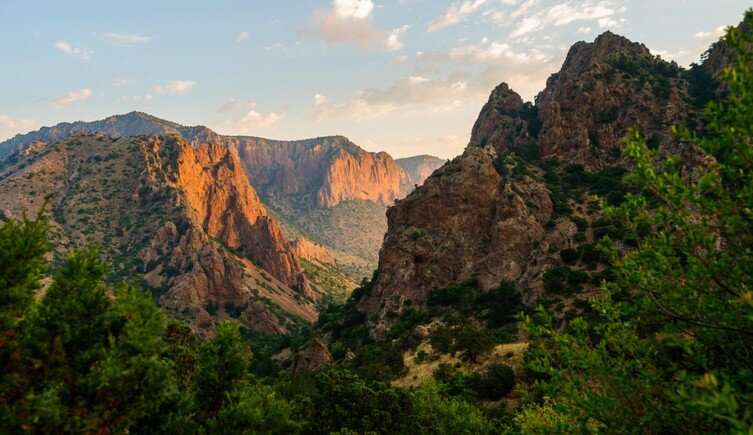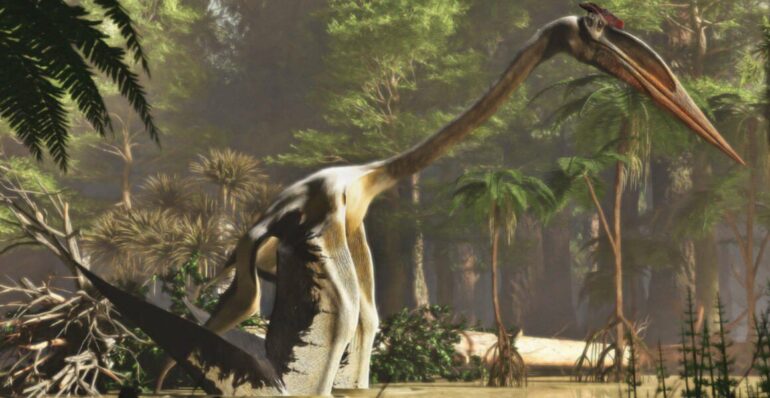The largest-ever flying animal acted like a giant heron, plucking prey from the water and launching itself into the air.
Quetzalcoatlus northropi was a pterosaur which ruled the skies for millions of years, alongside a newly discovered relative.
Some of the secrets of the largest animal to have ever taken to the air have been revealed, acting like a heron on the ground and a condor in the skies.
With the wingspan of a small airplane, Quetzalcoatlus northropi was a pterosaur living in the wetlands of what is now Texas, U.S. over 67 million years ago. Researchers have found that its 11-meter-long wings meant it would have had to jump up to 2.5 meters into the air, followed by powerful flaps to pull it into the sky.
The scientists also described a smaller relative, Quetzalcoatlus lawsoni, for the first time, which would have had a shorter wingspan, at around the length of a car. Together, these pterosaurs would have fed on a range of fish and small aquatic prey.
The co-editor of a series of recently published papers on the animals, Professor Brian Padian, says, “These ancient flying reptile are legendary, although most of the public conception of the animal is artistic, not scientific.
“This is the first real look at the entirety of the largest animal ever to fly, as far as we know. The results are revolutionary for the study of pterosaurs—the first animals, after insects, ever to evolve powered flight.”
The papers were published together as a “memoir” in the Journal of Vertebrate Paleontology.

Quetzalcoatlus northropi was discovered in Big Bend National Park in Texas in the 1970s. © Zack Frank/Shutterstock
The Texan titan
The largest ever pterosaur, Quetzalcoatlus northropi, was named in 1975 following the discovery of hundreds of bones in Big Bend National Park. The species was described from the large bones of the left wing, but many smaller bones were also found in other areas of the park in different layers of rock.
When these fossils were discovered, it was uncertain whether the smaller bones were simply young Q. northropi, or were from a different related species. In the end, scientists decided that they were probably a new species of Quetzalcoatlus, but did not carry out any further analysis to find an exact species.
Decades later, scientists have finally analyzed these smaller bones and found that they have a number of differences from the larger Q. northropi. These include changes in its skull structure and spine, suggesting that two other species of pterosaur were living side-by-side with the giant.
The majority of the finds are Quetzalcoatlus lawsoni, named in honor of Douglas Lawson, who first discovered the remains. As opposed to its larger relative, this species had a wingspan of around 4.5 meters long and was found in rocks dated to around 69 million years ago.
From around the same period researchers also found a few bones of a third species of pterosaur called Wellnhopterus brevirostris, which had a wingspan of three meters.
There is the potential for further species to be found at the site, but these will require further finds as the current unclassified bones lack the necessary detail to determine what they are.
The sky’s the limit
By classifying the different bones by species, and investigating their unique features, the researchers were also able to find out how the different Quetzalcoatlus species would have behaved.
The researchers first turned to the ‘chopstick-like’ beak, and found it was probably too delicate to have eaten meat or scavenged from carcasses. Instead, they suggest the animals probably acted like a large heron, plucking fish, invertebrates, small amphibians and reptiles out of the water and gulping them down whole.
Unlike some previous studies which suggested Quetzalcoatlus would be unable to fly, researchers found that the species would have been very capable by using a jumping start. The scientists argue the size of its wings would have prevented it using a running start as they would have hit the ground.
“If they could jump twice their hip height, to eight feet, the wings would be able to clear the ground and they could execute a deeper flight stroke,” Brian says. “This may be the best option for taking off, though it depends on sufficient power from the legs.”
Once in the air, Quetzalcoatlus would have soared like modern condors and vultures, with suggestions its large head may have helped it to complete turns. Though historic drawings have compared pterosaurs to bats, the wings would have only been attached to the front limbs like those of a bird.
When it came to landing it would have acted like an airplane, slowing until it is about to fall out of the sky before touching down.
“The animal had to flap its wings to stall and slow its descent before it lands with its back feet and takes a little hop,” Brian explains. “Then it puts down its front feet, assumes a four-legged posture, straightens itself out and walks away.”
This four-legged posture saw Quetzalcoatlus walk in a way unlike any animal alive today. While vampire bats also use their wings to help them move forward, the bone structure of the pterosaur would have prevented this.
“To avoid tripping, the animal first raised its left arm, then advanced its left leg in a full step, then it placed the hand on the ground,” Brian explains. “The process was then repeated with the right limb. It seems a cumbersome process to us, but the animal could execute the gait quickly and easily.”
This suggestion ties in with fossilized tracks found in France, which are too oddly shaped for any terrestrial quadruped to have made them.
The researchers now hope to discover more about Quetzalcoatlus, such as the shape of its wing membranes and how they would have affected its flight.
While pterosaurs ruled the skies for millions of years, in the end it was another flying object that brought their time to an end. When the meteor which brought an end to the dinosaurs struck in Mexico 66 million years ago, it also spelled the end for their flying relatives.
More information:
Matthew A. Brown et al, Preface, Journal of Vertebrate Paleontology (2021). DOI: 10.1080/02724634.2020.1853560
Matthew A. Brown et al, The discovery, local distribution, and curation of the giant azhdarchid pterosaurs from Big Bend National Park, Journal of Vertebrate Paleontology (2021). DOI: 10.1080/02724634.2020.1780599
Brian Andres, Phylogenetic systematics of Quetzalcoatlus Lawson 1975 (Pterodactyloidea: Azhdarchoidea), Journal of Vertebrate Paleontology (2021). DOI: 10.1080/02724634.2020.1801703
Brian Andres et al, Morphology and taxonomy of Quetzalcoatlus Lawson 1975 (Pterodactyloidea: Azhdarchoidea), Journal of Vertebrate Paleontology (2021). DOI: 10.1080/02724634.2021.1907587#_i8
Thomas M. Lehman, Habitat of the giant pterosaur Quetzalcoatlus Lawson 1975 (Pterodactyloidea: Azhdarchoidea): a paleoenvironmental reconstruction of the Javelina Formation (Upper Cretaceous) Big Bend National Park, Texas, Journal of Vertebrate Paleontology (2021). DOI: 10.1080/02724634.2019.1593184
Mark P. Witton et al, On the Size and Flight Diversity of Giant Pterosaurs, the Use of Birds as Pterosaur Analogues and Comments on Pterosaur Flightlessness, PLoS ONE (2010). DOI: 10.1371/journal.pone.0013982
Nicholas R. Longrich et al, Late Maastrichtian pterosaurs from North Africa and mass extinction of Pterosauria at the Cretaceous-Paleogene boundary, PLOS Biology (2018). DOI: 10.1371/journal.pbio.2001663
Provided by
Natural History Museum
Citation:
The largest-ever flying animal behaved like a giant heron (2021, December 23)


